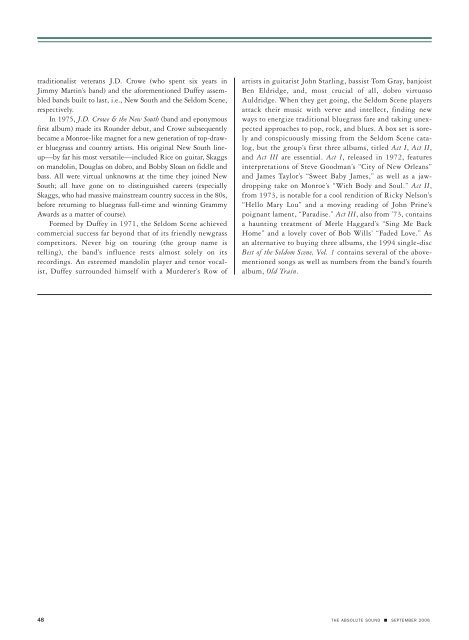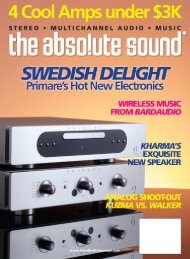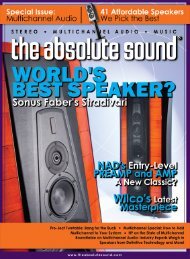The Cutting Edge
The Cutting Edge
The Cutting Edge
You also want an ePaper? Increase the reach of your titles
YUMPU automatically turns print PDFs into web optimized ePapers that Google loves.
traditionalist veterans J.D. Crowe (who spent six years in<br />
Jimmy Martin’s band) and the aforementioned Duffey assembled<br />
bands built to last, i.e., New South and the Seldom Scene,<br />
respectively.<br />
In 1975, J.D. Crowe & the New South (band and eponymous<br />
first album) made its Rounder debut, and Crowe subsequently<br />
became a Monroe-like magnet for a new generation of top-drawer<br />
bluegrass and country artists. His original New South lineup—by<br />
far his most versatile—included Rice on guitar, Skaggs<br />
on mandolin, Douglas on dobro, and Bobby Sloan on fiddle and<br />
bass. All were virtual unknowns at the time they joined New<br />
South; all have gone on to distinguished careers (especially<br />
Skaggs, who had massive mainstream country success in the 80s,<br />
before returning to bluegrass full-time and winning Grammy<br />
Awards as a matter of course).<br />
Formed by Duffey in 1971, the Seldom Scene achieved<br />
commercial success far beyond that of its friendly newgrass<br />
competitors. Never big on touring (the group name is<br />
telling), the band’s influence rests almost solely on its<br />
recordings. An esteemed mandolin player and tenor vocalist,<br />
Duffey surrounded himself with a Murderer’s Row of<br />
artists in guitarist John Starling, bassist Tom Gray, banjoist<br />
Ben Eldridge, and, most crucial of all, dobro virtuoso<br />
Auldridge. When they get going, the Seldom Scene players<br />
attack their music with verve and intellect, finding new<br />
ways to energize traditional bluegrass fare and taking unexpected<br />
approaches to pop, rock, and blues. A box set is sorely<br />
and conspicuously missing from the Seldom Scene catalog,<br />
but the group’s first three albums, titled Act I, Act II,<br />
and Act III are essential. Act I, released in 1972, features<br />
interpretations of Steve Goodman’s “City of New Orleans”<br />
and James Taylor’s “Sweet Baby James,” as well as a jawdropping<br />
take on Monroe’s “With Body and Soul.” Act II,<br />
from 1973, is notable for a cool rendition of Ricky Nelson’s<br />
“Hello Mary Lou” and a moving reading of John Prine’s<br />
poignant lament, “Paradise.” Act III, also from ’73, contains<br />
a haunting treatment of Merle Haggard’s “Sing Me Back<br />
Home” and a lovely cover of Bob Wills’ “Faded Love.” As<br />
an alternative to buying three albums, the 1994 single-disc<br />
Best of the Seldom Scene, Vol. 1 contains several of the abovementioned<br />
songs as well as numbers from the band’s fourth<br />
album, Old Train.<br />
48 THE ABSOLUTE SOUND ■ SEPTEMBER 2006










